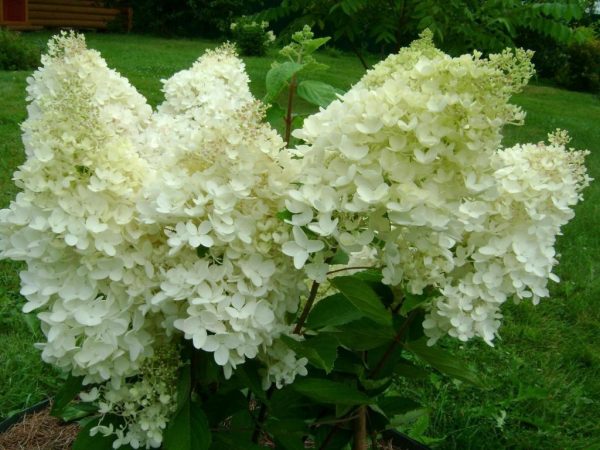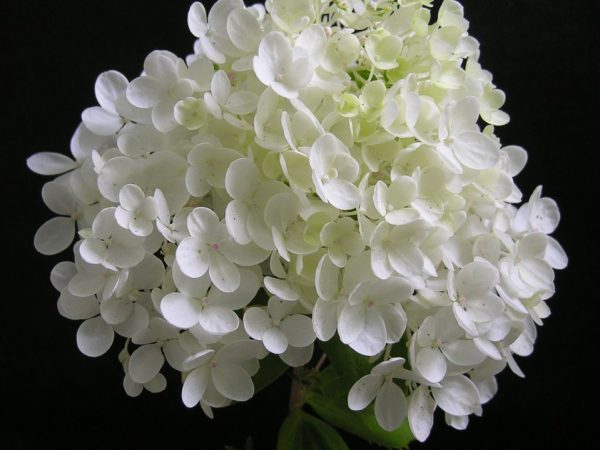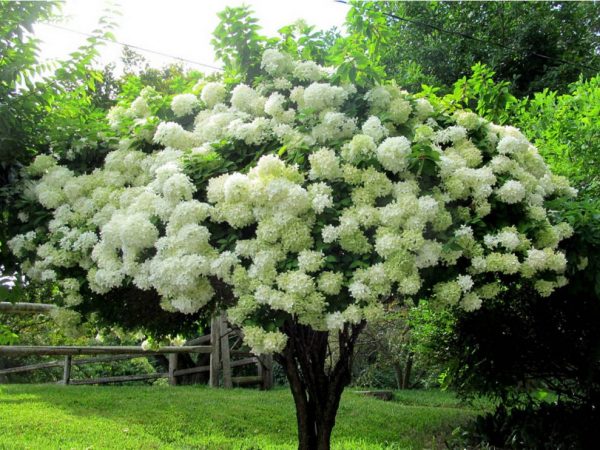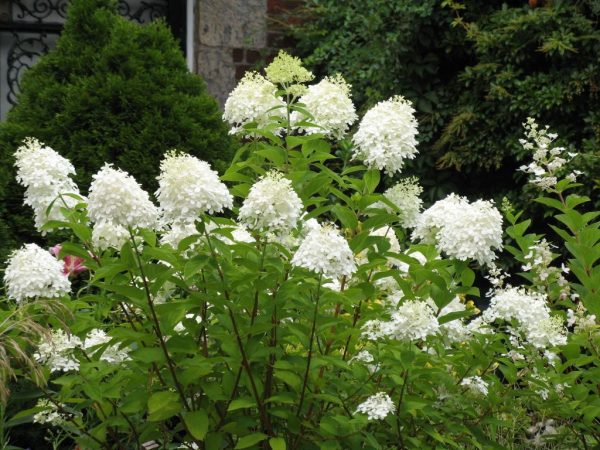Hydrangea Grandiflora - planting and care rules
The ancient panicle hydrangea Grandiflora is native to eastern Asia. The variety was bred in 1860. This plant with large inflorescences is used in landscaping both private gardens and industrial areas. Consider the main characteristics of the species, the rules of planting and care.
- Description of the variety
- Landing rules
- Timing
- Place and soil
- Seedling preparation
- Landing technique
- Care
- Watering
- Mulching and loosening
- Top dressing
- Pruning
- Preparing for winter
- Reproduction methods
- Cuttings
- By dividing the bush
- Diseases and pests
- Chlorosis
- Powdery mildew
- Rust
- Gray rot
- Ring spot
- Leaf aphid
- Spider mite
- Slugs
- Prophylaxis
- Application in garden design
- Testimonials
- Useful videos

Hydrangea treelike grandiflora
Description of the variety
The botanical name is hydrangea paniculata grandiflora. In its natural environment, this perennial can reach 10 m in height, in cultivated form no more than 2 m. It is characterized by intensive growth - it stretches up to 25 cm per season.
Long bloom - lasts from early July to mid or late September. The plant is winter-hardy (zone 5 - withstands lowering to -29 ° C), therefore it is suitable for cultivation in regions with warm and temperate climates.
External description:
- shrub with a dense crown (circumference up to 1.5 m), suitable for forming a small tree.
- leaves of an emerald tone, oblong with a sharp tip and jagged edges;
- stems burgundy or dark brown, erect, slightly pubescent, under the weight of the buds can bend to the ground;
- the flowers are small, collected in dense and large panicle inflorescences with a circumference of 30 cm, the color is snow-white or cream, closer to autumn they acquire a light pink hue.
Landing rules
Timing
The best time to plant is spring. Usually planted in mid or late April, when the soil warms up to a temperature of 10-12 ° C, the street heat stabilizes at around 14-15 ° C.
In regions with warm climates and long summers, it can be planted in early autumn - until the last days of September. 1.5-2 months before the first frost, the bushes will have time to take root and prepare for winter.
Place and soil
Hydrangeas prefer to grow in a sunny location, but with the possibility of shading at lunchtime.
When planted in the open sun, foliage and inflorescences will quickly burn out and the shrub dries out. In full shade, the flowering will not be as abundant and prolonged, the stems will begin to stretch, and the leaves will be small and pale.
Choose a windless place on a hill. The optimum depth of groundwater passage is 2 m.
The soil is preferably loamy with an acidic or slightly acidic reaction. Before planting, sand, vermiculite or perlite is added to the site so that the earth is looser and lighter. 1 m² will require 20 kg of substance.
Seedling preparation
You can purchase planting material with all varietal characteristics in one of the gardening stores. Choose grown up bushes. The optimal age is 2-3 years: they have a well-developed root system, and the crown has several leafy stems.
When buying, carefully examine the shoots, leaves and buds - they should be juicy, fresh, color in accordance with the variety.On their surface there are no mechanical injuries, signs of infection with diseases and pests.
Buy specimens with an earthen ball or planted in a container. Until the moment of transplanting into open ground, the root system is protected from drying out.
Before planting, the seedlings are dipped in cold water for a couple of hours, then cut to 2-3 cm in length. This will help the roots take root faster and start growing new roots.
Landing technique
Pits are harvested two weeks before planting. In group cultivation, a distance of 1.5 m is observed between them, taking into account the crown of an adult bush. Approximate parameters - 50x50x60 cm.
1/3 of the volume is filled with drainage - covered with a mixture of pebbles, crushed stone, screenings and brick chips. Then a fertile composition is laid half the depth - humus, sod soil, sand and peat are mixed in a ratio of 2: 2: 1: 1.
The soil mixture is trampled down, a hole is pulled out in the center, the roots are lowered into it, straightened, sprinkled with soil, tamped. After planting, the seedlings must be watered abundantly - a consumption of 20 liters per bush. To avoid drying out the earthen coma with roots, sprinkle with a thick layer of mulch (sawdust or compost).
When planting, it is not necessary to deepen the root collar, otherwise, at the very first watering, the plant will begin to rot and die.
Care
In the first two weeks, the seedlings are covered from the scorching sun to prevent them from drying out and dying. Use agrofibre or burlap.

Hydrangea grandiflora description
Further, standard care is required, as for other paniculate varieties of hydrangeas.
Watering
In the first month, the seedlings are watered every day to help them take root faster. A bucket of water is poured under one bush.
Then they moisten as the earth dries out to a depth of 5-6 cm. When watering, the amount of seasonal precipitation is taken into account - in a rainy summer, they should be abandoned, because the shrub will quickly die from excess moisture.
For adult plants that have begun to bloom, the following scheme is applied:
- at the beginning of spring, when the vegetative buds have not yet had time to bloom;
- two weeks before flowering;
- after its completion;
- in the fall, when the shrub leaves the foliage.
Mulching and loosening
The next day, loosening is carried out so that the soil passes moisture and oxygen well. In parallel, weeds are removed, weeded between the bushes. Then add mulch from peat, compost or humus to prevent rapid evaporation of moisture.
Top dressing
In the first three years, the seedlings have enough nutrients that were laid during planting. After that, you need to feed it several times per season.
Scheme:
- In early spring, before the start of sap flow, the near-stem circle is spilled with a liquid nitrogen-containing fertilizer - a solution of urea, nitrophoska or nitroammofoska: 15 g per 10 liters of water. 5 liters are poured under one bush. This stimulates the growth of the root system and green mass.
- At the budding stage, fertilize with a complex composition - dissolve 1 tbsp in a bucket of water. l. superphosphate and potassium sulfate. Consumption - 5 liters per seedling. These trace elements contribute to high-quality and long-lasting flowering. The same composition is watered after the buds have dried.
- The last feeding is carried out in the fall, when the hydrangea has shed its foliage. Leaf compost or last year's manure - 10 kg / m² is placed in the trunk circle.
All top dressing is combined with watering, which improves the quality of nutrient absorption and prevents burns on the roots.
Pruning
The panicle hydrangea needs a regular haircut, which helps to maintain the decorative and compact shape of the crown, and also prevents the appearance of infections and pests.
For better bushiness, immediately after planting, pinch the top of the seedling. Next year, he will begin to rapidly develop side branches.
Every spring, before the start of sap flow, frozen, shriveled, broken off and diseased shoots are cut out. Throughout the growing season, crooked stems growing inward are cut.
Some gardeners form a tree-like crown on the shrub. On a young seedling, the strongest branch is determined, all lateral processes are trimmed by 1/3. The next year, they are completely cut out, and young stems in the lower part of the trunk are also removed, and the top is pinched. A year later, several more thick stems are chosen to create a beautiful and thick cap - they are shortened by a third of the length in order to stimulate the development of a young growth. They are engaged in the formation of a tree crown for 6-8 years in order to achieve the desired result.
All manipulations are carried out using a sharp and disinfected secateurs. After the procedure, they are irrigated with a solution of copper sulfate to protect against infection.
Preparing for winter
At an early age, hydrangea needs good insulation, because has a weak resistance to frost.
A week before the first autumn frosts, the trunk circle is covered with a thick mound of peat or humus. Then the twigs are tied into a bunch and wrapped in burlap or covered with spruce branches.
From the age of three, you should not cover the shrub, you just need to sprinkle it with mulch.
Reproduction methods
There are two ways to get new seedlings from a shrub already on the site, the main thing is to adhere to the rules of harvesting the material and the technology of its planting.

Hydrangea paniculata grandiflora photo
Cuttings
Cuttings are cut during spring cleaning or summer. Take stems of the current year 15-20 cm long from the top of the crown. A prerequisite for successful rooting is the presence of two nodes, leaves and buds.
In the lower part, an oblique cut is made, all the leaves are removed, the upper ones are cut in half so that the shoot does not dry out. They are dipped for an hour in one of the root formation stimulants, then planted in open ground in a loose and nutritious mixture of peat, sand and leafy earth (1: 2: 1). Watered with warm and settled water.
The seedlings are shaded at lunchtime from the scorching sun, and moisturized if necessary. When the temperature drops sharply at night, they cover it with a film, and open it in the morning.
It can take 2-3 weeks for rooting. You can determine the success of such reproduction by the new leaves on the cuttings. A month later, when they are overgrown with roots, they are seated separately in the garden.
By dividing the bush
Usually this propagation is used for old hydrangeas, which have ceased to grow young shoots, foliage and began to bloom poorly. Also, this method is suitable for shrubs with damaged rhizomes. They are difficult to save, but it is possible to get new seedlings to preserve the variety.
The technique consists of several stages:
- the plant is watered abundantly, after an hour it is dug up and, together with the roots, is dipped into a container of water;
- the root system washed from the ground is dried, cut into several parts with the help of a garden shovel, so that each one has roots, one shoot with buds;
- the places of the cuts are treated with copper sulfate, then sprinkled with charcoal;
- after drying, the seedlings are planted separately according to the same scheme as the purchased bushes.
If you propagate a shrub with rotten roots, then first you need to cut out all the rot, put it in a fungicide solution for an hour, and dry it. Then everything is done according to the technology described above.
Diseases and pests
Hydrangea paniculata grandiflora loses its immunity if the rules of care are violated. Then various infections and pests begin to attack it.

Hydrangea grandiflora grandiflora
Chlorosis
It occurs when there is a lack of iron in the soil. Signs - the leaves turn pale, then turn yellow, while the central vein remains green. The situation can be corrected by spilling the near-trunk circle with chelating preparations that contain iron.
Powdery mildew
This is a fungal disease that appears in damp and rainy weather on thickened shrubs. Signs - a whitish bloom on foliage and inflorescences.Over time, the affected areas become oily, darken and die off. First, the diseased parts are removed, then the crown is irrigated with a fungicide - Skor, Topaz, Hom.
Rust
Reddish shapeless growths on the surface of leaves, stems. Without timely treatment, the infected areas turn yellow, die off and fall off. Treat the disease with Bordeaux liquid, Rilomida gold or copper sulfate.
Gray rot
A fungal disease that affects foliage, buds, then passes to inflorescences. All parts are covered with brown spots with a grayish bloom. In the fight against gray rot, Azocene solution or Bordeaux liquid is used.
Ring spot
Symptoms are rounded brown spots about 2cm in diameter on the leaves. Over time, the foliage deforms, curls. The plant stops growing, forms small inflorescences, or does not bloom at all. It is not subject to treatment, so the bush is dug up, burned. The place of growth is spilled with fungicides or a raspberry solution of potassium permanganate.
Leaf aphid
It feeds on the sap of the leaves, which leads to their wrinkling, yellowing and dropping. Leaves a sugary discharge on the surface of the foliage, which is an excellent medium for the appearance of a sooty fungus. At the initial stage of infection, treatment with an ash and soap solution is effective. The advanced stage is treated with Akarin, Iskra, Aktara, Fitoverm or Bison.
Spider mite
You can identify this parasite by a small cobweb on the underside of leaves and flowers. Later, the leaves turn yellow, a marble pattern appears on them. At the beginning of the lesion, the crown is sprayed with soapy water. If it does not help, apply Fitoverm, Akarin, Lightning or Tiofos.
Slugs
Plant in thickened plantings, eat young and adult leaves. In the fight against this insect, Molluscicide or Slug-eater is used. Scattered over the surface where pests parasitize. To avoid re-infestation, sprinkle the soil around the bushes with coniferous sawdust or wood ash.
Prophylaxis
To maintain the health and decorativeness of hydrangeas, you must adhere to simple prevention rules:
- buy strong and fresh seedlings without mechanical injuries and signs of diseases, harmful insects;
- observe the planting scheme, watering and nutrition regime;
- keep the garden clean - remove weeds in time, weed and loosen the soil;
- timely cut out diseased and non-viable parts on the crown;
- irrigate the shrub in early spring and late autumn with Bordeaux liquid or copper sulfate.
Application in garden design
Hydrangea Grandiflora looks spectacular in a standard form, especially when decorating gardens in different styles - Scandinavian, English, rural.

Hydrangea grandiflora planting and care in the open field
It goes well with decorative perennials - roses, azaleas, rhododendrons, as well as dwarf conifers - fir, juniper, thuja and spruce.
It is planted near gazebos, terraces, in the center of the site, along the fences. Combine with other varieties of panicle hydrangea, creating a multi-colored composition.
Testimonials
Many gardeners prefer the cultivation of this particular variety:
- a universal shrub, which can be given not only a compact bush, but also a tree-like shape;
- blooms long and luxuriantly, which allows you to enjoy its decorative effect until late autumn;
- successfully reproduces in different parts, so there is no need to buy new seedlings for landscaping the garden.

